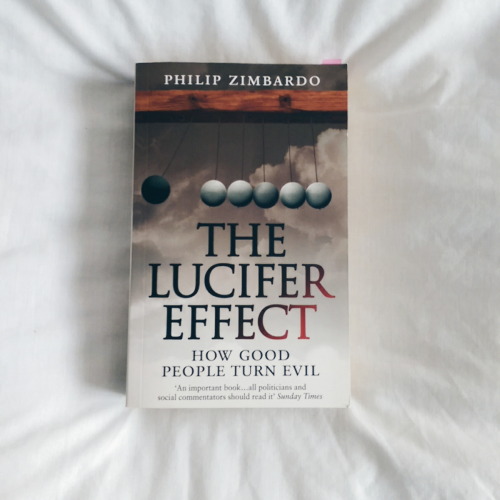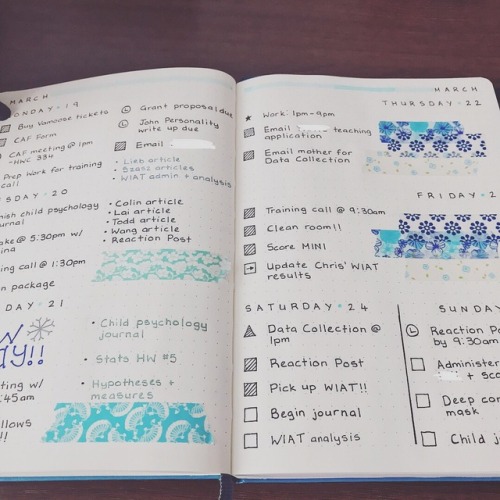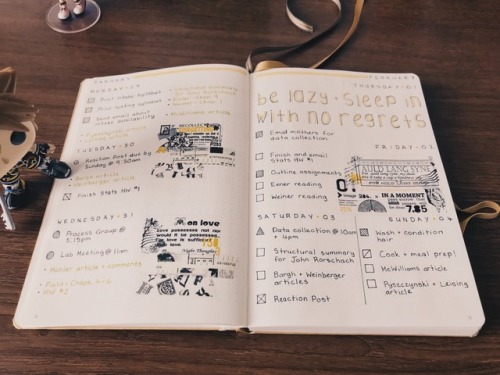#psychblr


5.4.20 - We got a kitten and named her Ekko.


12.14.19 - This semester is officially over. I have one semester left before I graduate with my associates and move on to bigger things. Now it’s time to relax.
› Enjoy the holidays!


11.9.19 - Trying to transition into a vegan diet. Feeling better already by simply making the choice for myself.
› Also trying to enjoy more sunsets lately so I’ll share this one with you too.

11.1.19 - The moon says hi.
› Happy November first!


10.31.19 - Getting into astrology. Found the cutest book on my sign.
› Happy Halloween!
Publication Date: February 9th, 2021
Rating: ★★★★★
As far as studying psychopaths, serial killers, and how they might have become the way they are, this book is an absolute gem. I knew when I started this that it was going to be a five star rating within the first few pages. Starting off with the preface, which was amazingly written and enticing the reader to continue reading, we read about the last “celebrity” serial killer of the epidemic years and a name everyone knows: Jeffrey Dahmer. Enough of a blurb to show how lives can change forever in one day and really kickstart the whole book.
Vronsky writes an absolutely fascinating introduction to the “golden years” of serial killers. His writing is clear and concise, and absolutely filled with interesting statistics, facts, and information. Organized by decade based on the adaption of serial killers in the time and featuring prominent killers in the media, we also learn about outside influences each decade that could help cook up the perfect storm that makes psychopaths commit these heinous acts. Things like wars and fathers with PTSD, media such as movies and magazine filled with dark themes in post war times, the politics of race and underreporting of black victims, the brain of a psychopath and the damage that can cause a shift in personality, etc.
One of the greatest parts of this book for me had to be Vronsky’s thorough use of his research and citations. I took down so many of his citations for science journals and books that I want to read to do further research. He remains seemingly objective to everything and merely writes things as they are, which is a talent to be respected when dealing with atrocities that break your heart. He is such a good writer that some of the descriptions and reading about the lives of the victims is devastating.
Thank you to Peter Vronsky, Berkley, and NetGalley for the opportunity to read this ARC, especially for such a well-written book.
-
Saylor Rains
Find me and this review on Goodreads.
Maniac: The Bath School Disaster and the Birth of the Modern Mass Killer by Harold Schechter (A TRUE CRIME BOOK)
Release Date: March 9th, 2021
Rating: ★★★★★
(I would highly recommend this to those who study/are interested in true crime, forensics, serial killers/mass murderers, psychopathy, nature vs. nurture, etc.)
Maniac is an amazing piece of work, but it also hurts like hell. Harold Schechter is thorough and devastating in this true crime chronicle of a “human time bomb” whose acts of violence seem to foreshadow an era of mass murder and bombings.
Schechter consulted books, newspapers, journals, census records, and so much more to detail the lives of so many people and communities together in order to accurately tell the story of The Bath School Disaster. There are so many elements that played a part in making this book as good as it was. The background into the area that would become Bath, the life stories of the immigrants who would give birth to Andrew Kehoe, the contemplation on the public’s tendency to remember certain crimes for generations while others, such as this one, that are just as publicized and heinous are forgotten almost overnight. The inclusion of other events throughout the story to help you understand what was shaping the way people lived at the time, and even to remind you of all the things happening at once that you don’t think about, was incredible.
Using records, quotes, and facts, Schechter gives you the information you need to make your own analysis. Andrew Kehoe was the first son born after six daughters and thus pressure was placed on him to be the heir, especially in comparison to his siblings’ successful lives. Placed on a pedestal and developing a pathologically inflated sense of self-importance. Reportedly a genius who was cold and distant, as well as a loner. You read the reports from others that show cruelty in the first half of his life. For true crime readers this book has a little bit of everything that we tend to see and study in a mass murderer, but with a relatively above average life at the time and a seemingly good environment what could have caused it?
In the climax of the story, the events leading up to and during the bombing of the school, my heart was palpitating. The short snapshots throughout this chapter felt like the flashing scenes in a movie before bad things happen that drive up your anxiety. The worst part was the aftermath. The newspaper reports and witness accounts of the reactions of the parents and the community, as they lose 45 people to Kehoe’s horrifying act, most of them children. This book’s worst quality is that it’s so real.
While my heart is aching after reading this, I can’t help but be impressed with Harold Schechter and his ability to put these events to paper with so much going on at once, and to have me at the edge of my seat the whole time I was reading it. This is definitely an author who stands out, and one who I’ll have to read more from.
Thank you to NetGalley, Little A, and Harold Schechter for this advanced review copy, this was a great book to read and you broke my heart.
–
Saylor Rains
Find me and this review on Goodreads.
Neuroscientist captures an MRI of a mother and child
Professor Rebecca Saxe (MIT) has taken the first ever MR image of a mother and child.
“This picture is an MR image of a mother and a child that I made in my lab at MIT. You might see it as sweet and touching… an image of universal love. We can’t see clothes or hairstyles or even skin colour. From what we do see, the biology and the brains, this could be any mother and child or even father and child at any time and place in history; having an experience that any human can recognise.
Or you might see it as disturbing, a reminder that our human bodies are much too fragile as houses for ourselves. MRI’s are usually medical images and often bad news. Each white spot in that picture is a blood vessel that could clog, each tiny fold of those brains could harbour a tumour. The baby’s brain maybe looks particularly vulnerable pressed against the soft thin shell of its skull.
I see those things, universal emotions and frightening fragility but I also see one of the most amazing transformations in biology.”
Post link
9:00 // Royal Holloway, University of London is beautiful.
I’ve been running experiments with a masters student using fMRI (functional magnetic resonance imaging). I also got an updated scan of my own brain. Nice nice.
Some cool stuff about fMRI experiments:
- Glasses can’t be worn in the scanner (because they contain metal) so you get to wear these sexy specs instead. The lenses that work best for you are slotted in. They’re like swimming goggles.
- People who wear the hijab or a turban can go in the scanner with their head coverings on. Yay! All pins,metals and hair ties need to be removed though.
- Experiments in fMRI tend to have a maximum running time of 90 minutes.
- There is a panic button (looks like a pump) given to participants in the scanner, if you ever want to leave the scanner all you have to do is press it.
- If it’s not given by default you can ask to have a copy of your brain scan. Download a free software called Mango and play around with your brain!!
- The equipment tends to look old - our comps run Windows XP. You’ll see this in science quite a bit and think “why don’t they update??”. Operating systems (Windows/MAC OS) sometimes have updates that tamper with medical software and it can be hard to pinpoint what’s gone wrong. So if it’s working we don’t update it until there’s a reason on our part e.g. when it breaks.
Follow my Studygram: studyingbrains
Follow my Twittertoo!
Post link
Book Recommendations: Books that have helped me think and write critically when it comes to scientific literature. I’ve never gotten below a 4.0/1st in a lab report.
This post will be especially helpful for those taking psychology, neuropsychology, neuroscience, cognitive neuroscience, pharmacy etc. All books are written by world leading academic researchers and are very well referenced.
Bad SciencebyDr Ben Goldacre - 342pgs, Age 11+.
If there is a book on this list that you read, let it be this! Dr Goldacre focuses on the misuse of science by journalists, homeopaths, schools and big pharmaceutical companies. The book has a great segment on understanding “The Placebo Effect”. Other topics include; Brain Gym, misleading cosmetic adverts, issues with vitamin pills and “toxins”. He has a blog he runs Badscience.net that has great free articles! The book is beautifully referenced and really easy to read, definitely worth investing in. If you can’t spend money on the book just yet, there is a similar free talk here.
Drugs: Without the Hot AirbyProf David Nutt- 316pgs, Age 12+.
Prof Nutt incurred the wrath of the UK government when he put forth research papers stating that alcohol and tobacco were more harmful than many illegal drugs, including LSD, ecstasy and cannabis. In “Drugs”, he talks us through the science of what drugs are and how they work, quantifying and comparing the harms caused by different drugs, as well as drug addiction. This book is a great starting point and has educated me on all major drugs better than any textbook has. It’s written in simple English with numerous references and even has a wonderful segment titled “What should I tell my kids about drugs?”. I have had the pleasure of meeting Prof Nutt multiple times and given the slander he has endured, he remains passionate and dedicated to his field. Prof Nutt runs a website aimed at the general public Drugscience.org. There is a similar free talk here.
Bad PharmabyDr Ben Goldacre - 404pgs, Age 15+.
Another gem by Dr Goldacre, this is a slightly heavier text than the above two books but is a must read for those going into pharmacy or research. Bad Pharma explains where new drugs come from and issues with missing data in clinical trials. Companies run bad trials on their own drugs, which distort and exaggerate the benefits by design. When these trials produce unflattering results, the data is simply buried. Dr Goldacre discusses the issues with design and also the harms of not making the missing trial data available. This book is not ‘anti-drug’, this book highlights issues with publication bias and how this needs to be and can be mended in order for doctors and patients to make better informed decisions on the drugs they are prescribing/prescribed.There is a similar free talk here.
The Man who Mistook his Wife for a HatbyDr Oliver Sacks - 246pgs, Age 11+.
Written by the late Dr Oliver Sacks, this was the first book I purchased at the age of 13 in the field of neurology that made me go nuts for the brain. As a huge fan of Roald Dahl’s style, this book was just perfect. Dr Sacks turned patient case studies into short stories, inviting you into the incredible world of neurological disorders. The following phenomena are covered: visual agnosias, memory loss, Parkinsonion-symptoms, hallucinations etc. Dr Oliver Sacks has multiple books that are worth investing in, have a look at Oliversacks.com. There is a similar free talk here.
Phantoms in the BrainbyDr V. S. Ramachandran - 257pgs, Age 15+.
Ramachandran, through his research into brain damage, has discovered that the brain is continually organising itself in response to change. Phantoms in the Brain explores case studies and experiments invented by Dr Ramachandran like the Mirror Box to help understand the underlying issues. Examples of the case studies involve a woman who persists that her left arm is not paralysed (albeit her entire leftside is paralysed) and a young man loses his right arm in a motorcycle accident, yet he continues to feel a phantom arm with vivid sensation of movement. In a series of experiments using nothing more than Q-tips and dribbles of warm water the young man helped Dr Ramachandran discover how the brain is remapped after injury. This book is really enjoyable and is a slightly more in-depth read than The Man who Mistook his Wife for a Hat. There is a similar free talk here.
The Lucifer EffectbyDr Philip Zimbardo - 488pgs, Age 18+ (due to explicit images).
Prof Zimbardo provides an in-depth analysis of his classic Stanford Prison Experiment, and his personal experiences as an expert witness for one of the Abu Ghraib prison guards, raising fundamental questions about the nature of good and evil. This book has really interesting commentaries on The Columbine Shooting, People’s Temple Mass Suicide, Prison Abuse in Afghanistan etc. I enjoyed the book but it does get really repetitive (it definitely could have been made shorter by 100 pages), the publishers also use a really small font. There is a similar free talk here.
Ages have been mentioned not as restrictions but as guidelines in terms of the writing style and sensitivity of the literature. Every book mentioned above doesn’t need to be read chronologically, from cover-to-cover. They have been compiled in such a way that you can dip in and out of the chapters without confusion. Lovely! All free talks are given by the authors and they cover the same topics that are mentioned in the books.
If you ever wish to discuss the literature, do get in touch with me! Twitter|Instagram
Post link
Before & During // 3 hours in and I took a step back to look at the mess.
I’ve been working at a really slow pace since university finished and decided today was the day to get a move on with something (just noticed the pics are slightly blurry haaaa sorry).
Post link


Bookstores and seashores


Beach knitting and flower picking in Brittany


Quimper in Brittany/France and the best cakes and teas.


01.09.19 Chartres in France


Beautiful oxford


Exams are in two weeks


Raindrops, Flashcards, summaries, knitting and ginger tea.


I went to the natural history museum on Tuesday and it was so beautiful ✨


Coffee shops and university
Need help with a certain lesson, assignment, or just want resources? Let me know :) ask box is always open for a reason and is mostly what I’m posting nowadays since that way I help you guys exactly with what you need. Also faster to post than my notes (I have a really big school load this sem).


New notebooks and crescent moons… ✨

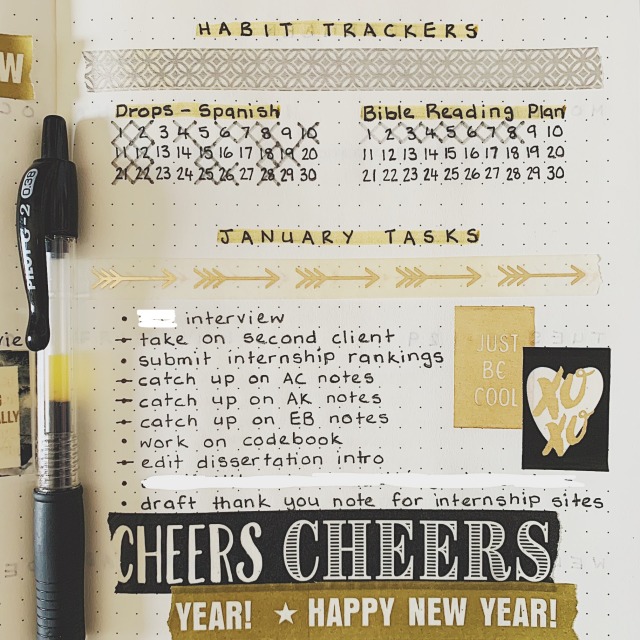

It’s April but #tbt to my January overview lmao. It wasn’t an eventful month, but it was somehow still busy because the internship application process was winding down and my final semester in my PhD program was beginning.

5.4 - 5.10
I’m a roll with posting so far lol. I found some free time to decorate this weekly spread from before. Cats and flowers are always nice so yeah

4.27 - 5.3
It’s been a while lol. To be honest, I’m terrible at maintaining a planner. I think I’m accepting that I can move at my own pace, and that it’s okay if I fall behind. So here is a spread from almost 3 months ago
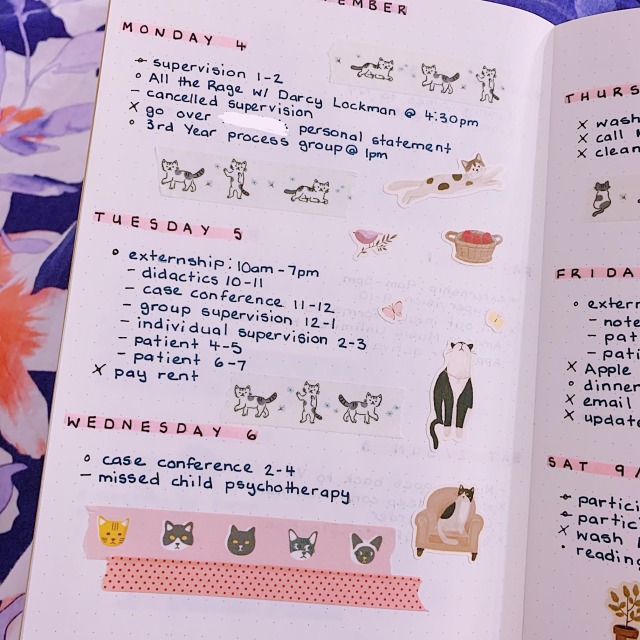


11.4 - 11.10
When you wish you had a cat, but you don’t so you just go overboard on cat stickers and washi in your planner.



Late post from 10.28 - 11.3
I’ve been so disorganized lately, it was nice to finally have a clear enough mind to decorate my planner.









My first trip to Kinokuniya NYC. How is it possible that I’ve been living in this city for 6 years and I’m just now coming to this store? Your guess is as good as mine. I spent enough to cover the membership fee and then some… partly due to that Prince of Tennis book I got. I used to be obsessed with the anime… guess I still am lol.



Thank you Seoul for feeding my stationery obsession.




When in Korea, you buy as much stationery as you can because it’s cheap and cute! I went a little crazy at the Morning Glory store, ARTBOX, Daiso, and Miniso . I regret nothing. One or all of these notebooks will help me write my doctoral dissertation…
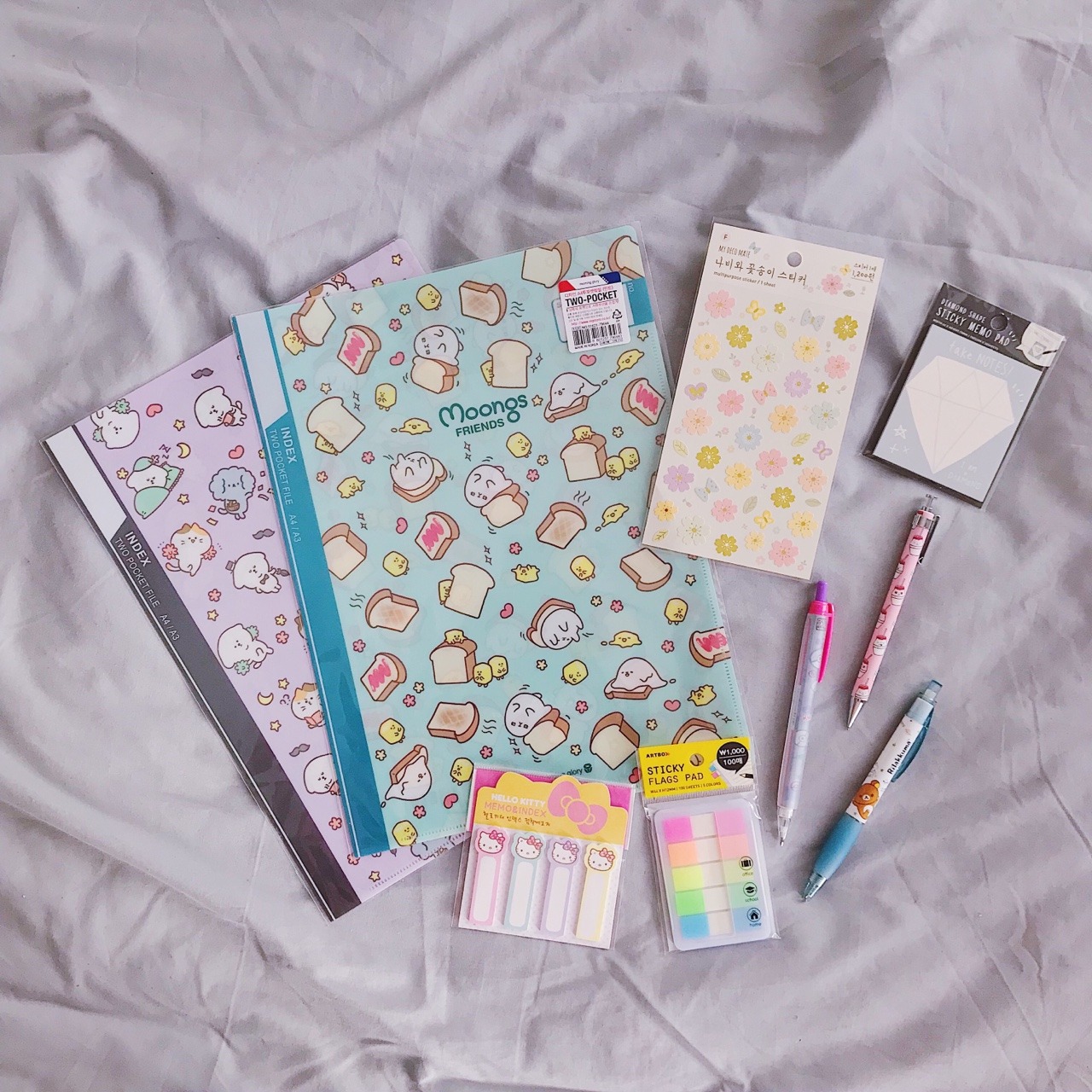

Is there anything more aesthetically pleasing than stationery??
Why do I keep collecting journals and notebooks? I don’t know but I COULD NOT resist this one… Many thanks to the lighting for making it seem as though I was wearing two different jeans for the same set of pictures.
Post link
The past two weeks have been hectic and I haven’t been to my Wednesday classes because of spring break and two snow days.
Post link
Just kidding, I definitely regret Thursday but only because Saturday did not go the way it should have. Anyway this is the past week’s spread featuring Sora holding it down for me.
Post link









